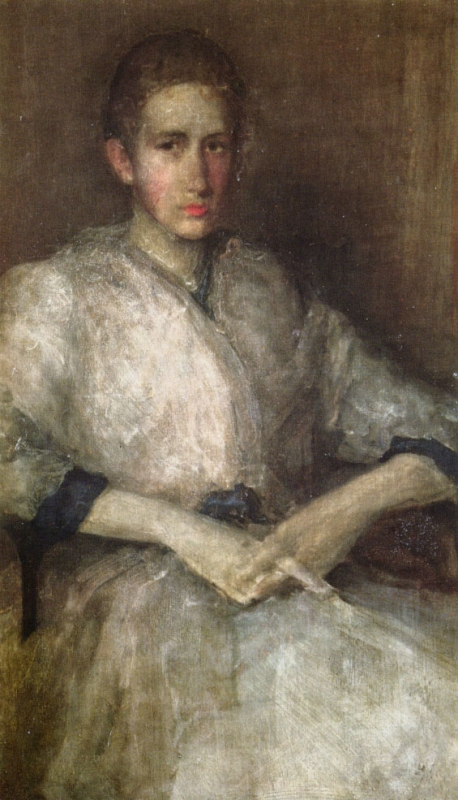Titles
Titles include:
- 'An unfinished portrait' (1895, Copley Society, Boston). 1
- 'Portrait of Ellen Sturgis Hooper' (1980, YMSM). 2
'Portrait of Ellen Sturgis Hooper' is the preferred title.
Description
A three-quarter length portrait in vertical format. It shows a young woman in a white dress seated facing the viewer, her arms resting on the arms of a chair, her hands crossed in her lap. The dress has a dark blue belt and trim on the sleeves. She is in slight three-quarter view to right. She has a long face with narrow chin, brown hair drawn back behind her head, perhaps into a bun, with tiny curls on her forehead. The background is pale brown. The light, such as there is, comes from the left. The overall tone is dark.
Sitter
Ellen Sturgis Hooper (Mrs John B. Potter) (1872-1974) . She married John Briggs Potter of Michigan, who, after studying art in Paris in the 1890s, later became curator of paintings at the Museum of Fine Arts, Boston. According to Armstrong, who interviewed the sitter,
'[Whistler] was interested in Ellen's copper hair and high coloring. She wore a dress made of material sent her by a cousin in Japan, Dr. W. S. Bigelow. It was Japanese linen with a dark blue folded edging and a blocked overall blue pattern. This was composed of ten characters, repeated, "which meant", she said to me with a little smile, "happy old age." Whistler talked very little during the sittings ... gave the impression of intense concentration, and painted on long after the best light was gone.' 3
She posed, holding a fan in her hand, in the studio at 21 Cheyne Walk, and her father attended all the sittings. Although they were pleased with the result, none thought it a good likeness.
Comments
The Leicester Galleries discussed this at some length, making some interesting observations, as quoted here:
'He created an atmosphere with his brushwork in portraits as in his “Nocturnes”. Fluid, flowing strokes, broad cross-hatching, and lively, ribbon-like strokes from long, slender brushes, build up an intricate surface. The figure, and flesh tones, complementing and emerging from the gauzy materials, created a fragile harmony. The surface glimmers with the quality of the material, the face glows with sultry colour against the misty hues of the dress.
The dress merges with the fan that Ellen held, dropping from a languid hand. It may have been taken from Whistler's own collection. Certainly fans of this shape appear in his paintings in the early sixties, ... in watercolours and pastels – particularly those of models nearly nude, draped in long gauzy robes of butterfly colours, which were his delight to the end of his life. The curving shape complemented the folds of drapery, the cool white matched her dress. White diffused daylight falls ... onto the girl in her white dress, so that she stands out from the warm creamy-brown shadows of the studio. Pattern, dress, fan, drapes, all are half concealed, half revealed, in typically Whistlerian fashion. Against the soft colours, the deep, dark blue splashes of colour at cuffs and neck, and the vibrant colour of lips and face emerge startlingly.
Ellen's face has the quality of an icon. Thinly painted, the elegant brushstrokes which are an integral part of the dress are much more restrained in the painting of the face. Whistler thought it important to conceal the means of achieving his ends, and in the early nineties struggled agonizingly with this self-created problem. Expressive brushwork, even flashy brushstrokes, had their place in enlivening and unifying the surface of the canvas. The unity of the whole surface was of paramount importance.
But an agitated surface did not suit the timeless quality he sought in the face. He painted and rubbed out and repainted the face so that the final result ... [had] the freshness of the first sketch, combined with the understanding gained from many. It was the result of long study expressed with “the experience of a lifetime”. In the attempt to create a lasting portrait, expressing more than a fleeting expression, Whistler came upon the problem that he was in fact painting the model at one moment in time and under a particular set of circumstances. The freshness of that moment was of value, and he sought to convey that value in colour and paint as truthfully and seriously as he could. But truth is capable of many interpretations. ' 4
Notes:
1: Loan Collection of Portraits of Women for the Benefit of The Boston Children's Aid Society and the Sunnyside Day Nursery, Copley Society, Boston, 1895 (cat. no. 880).
2: YMSM 1980 [more] (cat. no. 391).
4: Peter Nahum at the Leicester Galleries at http://www.leicestergalleries.com/19th-20th-century-paintings/d/james-abbott-mcneill-whistler/12691 (acc. 2017).
Last updated: 16th October 2020 by Margaret






